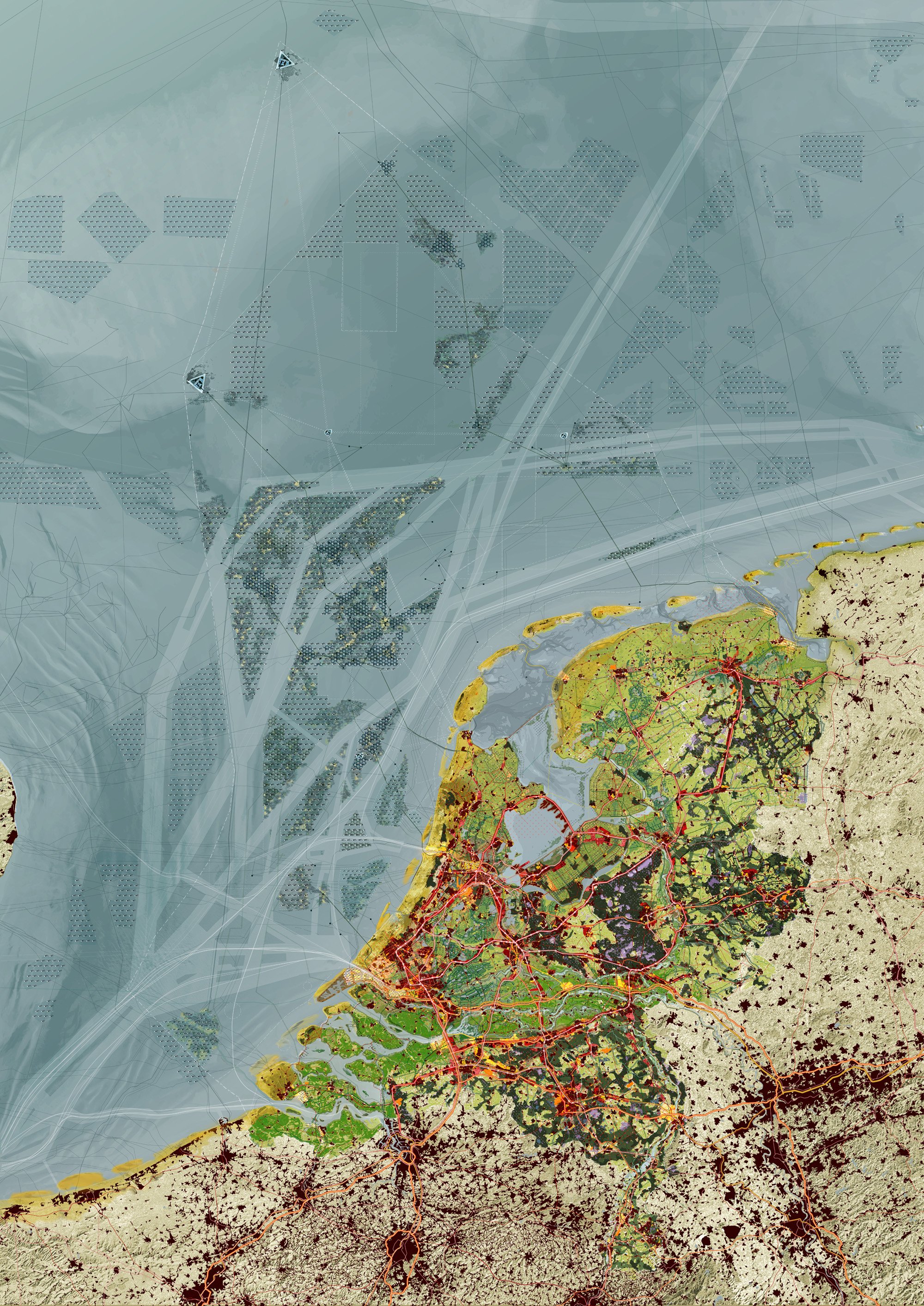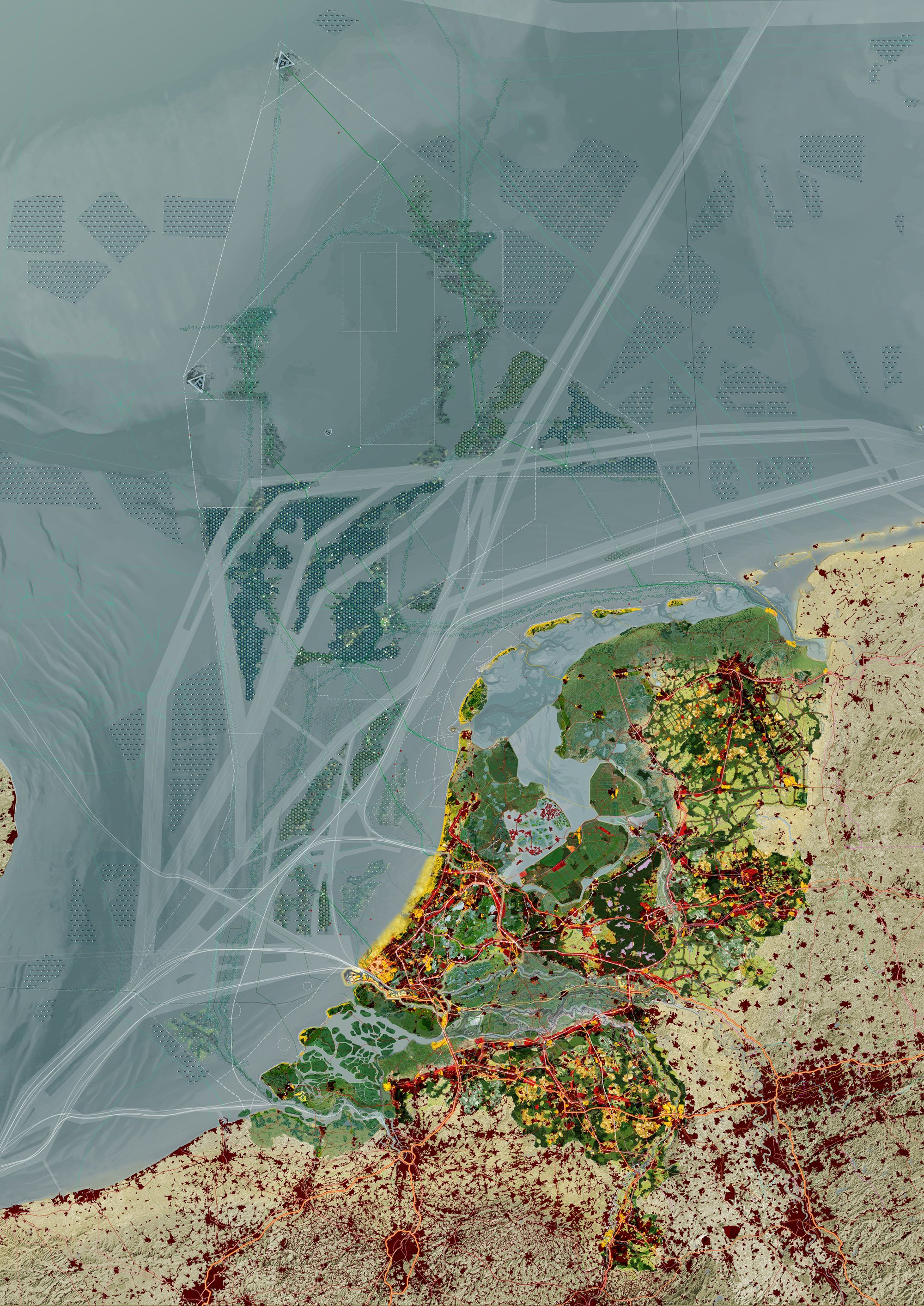
Future Perspectives for the Netherlands
The National Environmental Vision (NOVI) in the Netherlands includes maps outlining a potential future for the country based on the wishes and ambitions of the NOVI's perspective. The maps are not intended as national goals or final images but as possible future scenarios.
-
Location
The NetherlandsYear
2020 - 2022 -
Het ministerie van Binnenlandse Zaken en Koninkrijksrelaties
-
Design lead
Eric FrijtersProject lead
Rens WijnakkerTeam members
Duong Bui
Lisanne Corpel
“The NOVI provides guidance to the development of the living environment without imposing a blueprint.”
— Rens Wijnakker
A future perspective for the Netherlands
The discussions contribute to a realistic and collective understanding of the potential future of the Netherlands, with continuous updates reflecting evolving ambitions and possibilities. The map's legend is based on the NOVI's second chapter, interpreting and illustrating ambitions, uncertainties, and dilemmas in alignment with NOVI principles. These interpretations represent spatial translations of NOVI statements, emphasizing their potential nature.
The NOVI provides guidance to the development of the living environment without imposing a blueprint. It emphasizes a collaborative approach with partners to adapt to ongoing developments in a cyclical and adaptive process. The accompanying discussion map aims to visually demonstrate the spatial integration of urgent societal challenges while maintaining a high-quality living environment. It serves as a tool for discussing the execution and adjustment of the NOVI. The map is a vehicle for conversations about the desired layout and development of urban and rural areas within programs such as rural areas and urbanization.
“Challenges regarding energy, climate, food and possibly housing are partly given space on the water, creating a new, future-proof environment here too.”
— Rens Wijnakker
Seven major spatial themes
In the Netherlands, spatial constraints arise due to high demand for housing, infrastructure, and energy-related developments. The National Environmental Vision (NOVI) outlines three guiding principles—multiple spatial uses, leading identity, and no shifting of burdens—to address these challenges. The principles necessitate considering tasks collectively and locally, emphasizing multifunctional spatial utilization.
The NOVI integrates spatial ambitions across seven themes: water safety, nature, circular agriculture, industry, energy networks, energy production, and urban regions. The interconnected exploration of these themes results in thematic maps, synthesized into a discussion map, providing a comprehensive view of potential future spatial networks and structures.

Perspective 1: "Investing in Existing Quality" envisions moderate climate change with significant socio-economic growth, minimizing the need for extensive climate-adaptive measures. Urban areas thrive within the Stedelijk Netwerk Nederland, and landscape restoration occurs outside cities, emphasizing visible soil and water systems. High energy demand is met with offshore energy production, including space for biomass and food production.

Perspective 2: "Natural System" anticipates accelerated sea-level rise with limited socio-economic growth, leading to less urbanization and fewer resources for climate adaptation. Adapting to increased dynamics and potential sea-level rise-related challenges becomes crucial. Limited urban development occurs primarily on higher grounds, requiring a new balance with natural dynamics, including food and biomass production in saline and dynamic conditions.

Perspective 3: "Creating Space for Growth" assumes accelerated sea-level rise alongside significant socio-economic growth, resulting in high spatial pressure. Intensive urbanization, coupled with demands for nature, recreation, biomass, energy, and food production, prompts a "seaward" strategy. New islands off the coast provide additional urban development space, enhanced natural areas, and protection against flooding. West-Netherlands sees intensified urbanization, while East-Netherlands preserves space for sustainable food and biomass production. High energy consumption and spatial pressure pose challenges, potentially leading to increased energy imports or nuclear energy production in the country.
Three Spatial Scenarios for the Netherlands 2100
In the field of spatial planning, and landscape architecture, a lot of research is being conducted into the spatial consequences of the major transitions that are coming our way. To get an idea of what the transitions can mean spatially, a multitude of design studies have been inventoried. Three spatial studies, for climate change, energy transition and agriculture and nature developments, form the basis for three spatial perspectives. These are bundled into three perspectives that are based on the Delta Scenarios. Developments in the field of climate adaptation, energy transition, agriculture and nature, together with urbanization and mobility, strongly influence the use of space and transformation of the landscape. The spatial impact of these transformation processes is considerable and contains major uncertainties. Moreover, the various processes interact and compete due to the limited amount of space available.
As a result for our research a large number of variants have been bundled into three perspectives. These perspectives are loosely based on the indicators that form the basis for the Delta scenarios that Deltares published in 2017. The three perspectives are: 'Investing in Existing Quality,' 'Natural Systems,' and 'Creating Space for Growth.' You can see their spatial translation in the maps below.
In all these perspectives, the total available space within the entire Dutch territory has been explicitly taken into account. When formulating a spatial strategy, the space in the North Sea was also included as a solution space to tackle the issues that threaten the planetary boundaries. The sea as part of our landscape. Key principles include achieving a circular system with no net emissions and 22nd-century biodiversity, focusing on soil and water systems to establish a foundation for a good quality of life.
For the full report Een Toekomstperspectief Voor Nederland.
What can we do for you?
If you're interested in learning more about our innovative approach and the wide range of services we offer, simply drop your name and e-mail address in the form. We'll be in touch as soon as possible so you can have a closer look at what we can do for you.


